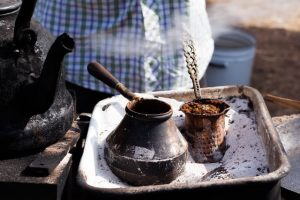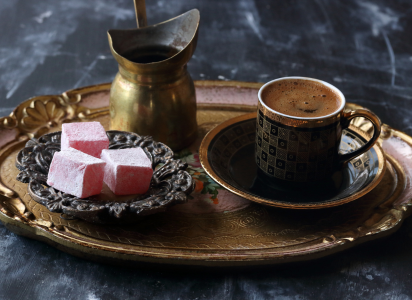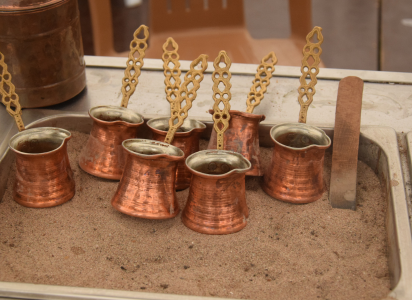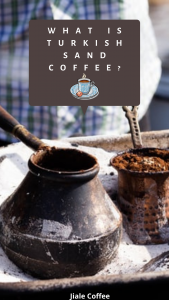
In this article, we are delving into not JUST Turkish SAND coffee, but also hot sand coffee… or Turkish coffee sand! We’ve heard it every way possible.
And yes, they are both different: while Turkish coffee refers to coffee from Turkey, Turkish Sand Coffee is a method of preparing coffee with sand in the pan used as the primary heating method. Keep reading below!
It was first discovered, or rather noticed, during the Ottoman Empire, between the 13th and 14th centuries. It, however, did not hold the same popularity that it has today.
Back then, original Turkish coffee was regarded as a drug, which under the law of both the Sultan and Quran, was prohibited. It was only later on, after people could not have enough of the coffee, that the Sultan made it legal.
Any coffee bean and variety of coffee can make this coffee. The only difference is the technique of brewing. Unlike with other coffee cups, this coffee includes the ground beans, which most strain out.
I love to make my sand coffee in a Turkish coffee pot that has received hundreds of 4.5 star reviews and also some, on Amazon. It is perfect for single-serve.
The powdered beans are added to boiling water, and milk if needed. They are then left to settle at the bottom of the cup. This is what makes this coffee both thicker and stronger than most coffees.
What Is Sand Coffee?
Turkish sand coffee is coffee from Turkey made in a special way, which as you guessed, involves sand…. essentially, it is sand brewed coffee. Pretty cool, right?
It is traditionally made using a special pot called a cezve or ibrik.

How Is It Made?
In normal Turkish coffee brewing, the cezve is directly placed over an open fire and brought to a boil. In the Turkish sand coffee, sand is placed in a cooking pan and heated. The sand acts as a heat regulator.
If you’re looking for Cezve with a set of 2 beautiful cups and saucers, then this one has earned over a 100 reviews, resulting in 4.5 stars overall, at Amazon. We highly recommend it.
When the cezve sits in the sand, they are regularly heated. The deeper the cezve goes into the sand, the hotter it gets. Turkish sand coffee is baked, rather than boiled.
Is the Sand Option Better Than the Original Brew?
Regarding aroma and freshness, Turkish sand coffee is better than the original brew. Given the fact that the ground coffee beans are left to sit in the coffee cup, the aroma is automatically stronger.
The freshness factor comes in when you grind your beans instead of buying already packaged coffee powder. It is assumed that commercial and bulk coffee bean packaging does not pay enough attention to the quality of the coffee beans.

However, when you grind the coffee by yourself, you can sort through the beans, only picking the ones that are in good condition.
For people who do not like the strong, and sometimes bitter taste of coffee, the Turkish sand coffee might be too bitter. Most Turkish sand coffee brewers prefer to add spices, such as cardamom, and maybe even sweeten and cream each cup.
Are There Machines Available on the Market?
When you do not have sand and a pan in your house, but you still want to make Turkish sand coffee, you can invest in one of a few machines.
Although there are not many machines that can perform the art of sand coffee making, there are at least a few available options.
One common one is the Copper Sand Brewer Machine. Since this technique is mostly traditional, it majorly occurs in areas where sand is readily available, and easy to find.
Let’s Dig Deeper into the Origin…
Turkish coffee is from the 16th century (1555, to be precise), when two Syrian traders introduced it to Istanbul. It took time for people to accept it, because when they interpreted the Quran, they considered it to be a drug, hence it was prohibited.
Despite the prohibition, the coffee still gained popularity, and the Sultan had to lift the ban. By the late 17th century, this coffee culture had spread to other countries, among which were France and Britain.
Best Brands
Now that we’ve covered what it is, let’s delve deep into the best Turkish coffee brands. This beverage is a unique brewing method from finely ground coffee beans, using an ibrik, with no need for cream or milk.
Experts can also tell your fortune, using the coffee sludge left in the cup.
To help you prepare the best tasting version of it, you need to identify the brands that will not compromise on quality. Below are some of the best Turkish coffee brands recommended by Jiale Coffee:
#1. KuruKahveci Mehmet Efendi
This is no doubt the most popular Turkish coffee brand in the world. The brand was named after the founder of the company, and since 1871, it has been a family-owned venture.
This legendary brand has decades of experience in coffee production and they have learned to perfect the art of making it for use at home. They have a well-known retail outlet in Istanbul.
#2. Nurettin Kocatepe
This brand has been in existence since 1919, but they took some of the top positions in the market later, in 1914, when they breached the boundaries and started selling internationally.
They are popular for their flavors. You can also find coffee with cardamom amongst their products. This makes Nurettin Kocatepe one of the best brands, for offering a variety of products.
#3. Cezbeli
Though it is relatively new on the market, as compared to other famous Turkish coffee brands, it has gained favor with enthusiasts.
Operating since 2009, they are based in Istanbul. They use 100% arabica coffee beans, unlike other producers who tend to mix arabica and robusta beans.
This has greatly contributed to its success, despite the pricing. Quality does come at a price, and people are willing to pay to get the best to quench their thirst.
#4. Tugba
Tugba has a rich history in selling dried nuts, and other Turkish sweet specialties.
While this brand operates from Turkey, it sells its products across the world. In Turkey, they have more than 60 retail stores to satisfy the growing demand for it.
In an effort to meet the world demand, they have an online coffee business to reach out to their consumers.
#5. Ozerlat
This brand is famous for upholding the tradition of roasting the coffee beans under firewood. It was founded in 1917, and since then, they always use arabica beans.
This is the main reason why they are a reputable brand. They do not mix arabica and robusta coffee beans, making it a pure brand ideal for enthusiasts.
Unlike recent brands, they still use traditional methods of roasting coffee beans, to bring out the best aroma.
Delving Into The History…

In Britain, the first coffeehouse was in the mid-17th century, opened by a Turkish Jew. The Turkish ambassador to France threw extravagant parties in the 1680’s for the elite members of society. African slaves had to serve them coffee in porcelain finjans, on silver and gold saucers.
It became a significant part of the ceremonies held in the Ottoman Court, and the Sultan enjoyed it when his coffee makers ceremoniously served him with it.
The people adopted it as part of their custom, and it became a ritual, playing a significant role during marriage ceremonies. For this reason, women underwent thorough training to learn how to make a perfect brew.
That meant that their potential husbands had to judge a woman’s wifely character based on how good her coffee-making skills were.
What’s interesting is that this practice still holds today. When a prospective groom’s family visits the bride’s home to propose, the bride-to-be serves them Turkish coffee.
The bride-to-be sometimes uses salt, instead of sugar, when serving the groom’s coffee, in a bid to gauge his character. If the groom portrays no signs of irritation or displeasure, then the bride-to-be assumes her husband-to-be is a patient and good-tempered man.
As much as the groom’s family may also gauge the woman’s coffee-making skills, the groom’s etiquette is also under examination. Therefore, he should accept whatever the bride-to-be offers him, with a smiling face.
However, serving the groom coffee with salt (instead of sugar) can also be an interpretation, in some communities within the country, that the woman does not want to be his wife.
It Becomes A Profession…
After the Sultan recognized the drink, and gave it high regard in the Ottoman Court, people also turned coffee making into a trade. They opened coffee houses, where they served Turkish coffee, along with other beverages.
Those who perfected their coffee-making skills could sell their services as specialty coffee makers, also referred to as kahveci usta, to high ranking officials who wanted their guests to enjoy the beverage.
It became very valuable, finding its way into the law where a woman was allowed to divorce the husband if he could not provide her with her daily need of coffee.
The first coffee houses in Istanbul started in 1554, and became the first meeting places for people to drink their coffee. According to some historical facts, such coffee houses were the ideal place for holding business meetings and for social gatherings, where people played games, such as chess and backgammon.
Unfortunately, in 1656, the law to shut coffee houses came into effect, issued by the Ottoman Grand Bizier, stating that they were illegal. It was such a serious offense to operate a coffee house that, if found, one would be drowned or beaten severely.
While the ban was quite a shock to the people, the Turkish authorities viewed the coffee as a threat to their Empire, since people used to gather in the coffee houses to discuss politics.
Some people wanted the fall of the Sultan, which the Turkish authorities did not take kindly. The people, however, had adverse reactions, with riots starting all over, which led to the authorities lifting the ban.
The Sultan did not stop at just lifting the ban; he placed heavy taxation on the coffee houses, to have them provide an extra income to the state.
How To Make A Slammin’ Mug of Sand Coffee!

Preparing or learning how to make it requires very finely-ground coffee, and you may use whichever coffee beans you prefer, though experts consider arabica to be the best.
If you cannot get it, you can use robusta or any other blend. Once you have your choice of beans, you should grind them until you have a very fine powder left in the pot as you serve the coffee.
You can use a manual grinder, since electric grinders may not have effective results. You may alternatively order from the coffee merchants in any part of the world, or buy the ready-made ones available in the shops.
What is a Cezve aka Ibrik?
One of the utensils you may require is a cezve (what it’s called in Turkey), but in other countries, it’s referred to as an ibrik. In english, we simply call it the Turkish coffee pot!
A cezve is a small pot specialized for coffee brewing, and made from copper. The right combination includes a 1:1 ratio of coffee and water, such that if you use one cup of coffee, you will need one cup of water.

Heat the mixture until it starts to froth, but before it boils over, you should remove it from the heat. If it has not come to the desired froth that you want, you can reheat it until it does, since serving this coffee without the foam is not acceptable.
Turkish Delights
Now that you know how to make it, you must learn about Turkish delights!!!
To do it right, you should have special porcelain cups called finjani. You should note that when you add some sugar while brewing the coffee, it must be the correct amount, because you are not supposed to add it after.
There are three ways of serving coffee: unsweetened (in which you do not add any sugar), with little sugar, and sweetened.
If you have a sweet tooth, then you will be delighted to know that Turkish Delights (gel-like dessert confections with nuts) are part of the ritual when it comes to serving this delicious coffee.
Also, if you prefer come spices, then you can add some cardamom, or whichever flavor sits right with you. Some people add vanilla, nutmeg, cinnamon, and others, depending on what you personally like the best.
Originally, the coffee never had sugar in it. Sugar found its way into Europe in the 16th century, and in 1776, Bekir Efendi introduced Turkish Delights.
The delights were to overcome the bitter taste of unsweetened coffee; therefore, people began to also serve guests coffee along with Lokum, a small sweet.
Countries That Appreciate It The Most

Some countries drink more when compared to others, and may have a little difference in how they prepare theirs.
For instance, in Bosnia and Herzegovina, they refer to Turkish coffee as Bosnian coffee, maybe because they have adopted their own way of brewing it.
In Bosnia, they start by boiling water, and when it reaches a boiling point, they pour some in a cup to use later. After that, they add the coffee and the remaining water to the cezve, and place them on heat to reach a boiling point.
It does not take long, because the water is already hot; a few seconds should do it. Bosnian coffee is an essential part of social gatherings, and is part of the traditional daily custom.
In Greece, when political tensions arose in the 1960s, they changed the name to Greek coffee.
As the strenuous relation between Greece and Turkey continued, Greek coffee gained popularity. However, nothing changed with regards to the fundamentals of this beverage; it was merely a substitution of one word for another.
By the 1990’s, advertising campaigns were promoting Greek coffee, although some Greeks still refer to the coffee as Turkish.
Introducing Turek…

In the Czech Republic and Slovakia, they have their unique way of preparing it, with a few differences. For example, they do not use the cezve aka Turkish coffee pot, but instead, they pour ground coffee into boiling water, and they refer to their beverage as Turek.
Unfortunately, Turek has become less popular, to the extent that cafes no longer serve them; if you want to enjoy your cup of coffee, you will have to go to a pub, kiosk, or prepare it at home. The decrease in popularity is due to an increased appreciation of espresso in the last several decades.
Turkish sand coffee is a special coffee brewing method that brings out a rich, thick, and deeper taste to the original.
Turkish Sand coffee brewing gives the coffee a longer time in the heat, therefore allowing for better preparation. This coffee is better for some people, compared to mainstream brewed coffee.
Others find the taste a little too bitter. However, it remains as a technique that everyone should try at least once in their lives.
After the Sultan recognized the drink, and gave it high regard in the Ottoman Court, people also turned coffee making into a trade. They opened coffee houses, where they served Turkish coffee, along with other beverages.
Those who perfected their coffee-making skills could sell their services as specialty coffee makers, also referred to as kahveci usta, to high ranking officials who wanted their guests to enjoy the beverage.
Coffee from Turkey became very valuable, finding its way into the law where a woman was allowed to divorce the husband if he could not provide her with her daily need of coffee.
The first coffee houses in Istanbul started in 1554, and became the first meeting places for people to drink their coffee. According to some historical facts, such coffee houses were the ideal place for holding business meetings and for social gatherings, where people played games, such as chess and backgammon.